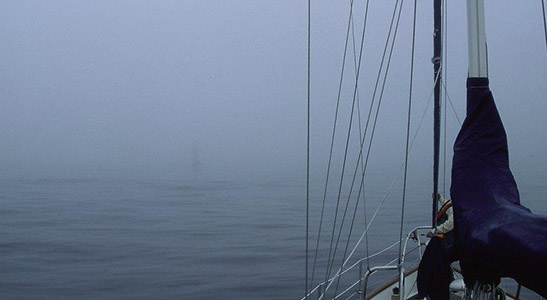It happened slightly over a month ago, while I was out sailing with three students. It was just a normal afternoon three-hour practice session. We do them almost every day, and sometimes twice a day. We had come out of the Berkeley Marina a few minutes earlier in order to practice reefing and overboard rescues.

Fog in the Bay doesn’t always advance from the Golden Gate at a predictable pace. It can actually form around a boat in less than a minute, leaving sailors with no points of reference at all. Photo courtesy of OCSC
It happened slightly over a month ago, while I was out sailing with three students. It was just a normal afternoon three-hour practice session. We do them almost every day, and sometimes twice a day. We had come out of the Berkeley Marina a few minutes earlier in order to practice reefing and overboard rescues. Nothing unusual about any of this—we were on a boat we had all sailed on previously, sailing on water that we had all sailed on many times before and about to practice very familiar maneuvers. And then suddenly . . . we couldn’t see anything!
That famous San Francisco Bay fog had been hovering out by the Golden Gate Bridge for most of the day. From Berkeley we had been able to see to the bridge, and just a bit beyond it. Land’s End, on the San Francisco side, and Point Bonita, on the Marin County side—both about two miles farther away—were not visible.
But this fog didn’t move in from the Golden Gate Bridge across the Bay to Berkeley. It wasn’t a thick, creamy white wall that we could see as it approached. Instead, we actually watched as the fog formed around us. It was like being enveloped in a very moist cloud of steam, except of course it was cool instead of hot.
Our visibility went from many miles to a few yards in half a minute. Nothing was visible, and even the surface of the water disappeared within 30 or 40 feet of the boat. The air wasn’t clear between us and the limit of our visibility either. We were not encircled by a fuzzy yet solid wall some 40 feet away. It was more like being inside a marshmallow. (For a quick explanation of what causes fog to form, visit http://www.weatheronline.co.uk/reports/wxfacts/Fog-and-Mist.htm.)
I hove the boat to, which is a way of coming to a stop without anchoring. I wouldn’t deliberately sail into thick fog just for the learning experience. However, since the fog had come to us, I wanted my students to have some time to experience this and to gain some sense of what this form of sensory deprivation truly means. For most of us, vision is our primary sensory mode and when it is suddenly removed, it can be very disconcerting.
We sat there for a short time, just absorbing what we were feeling, until one of my students asked, “Which way do we go to get out of this?” My answer was, “We will steer 140° Magnetic and proceed very slowly until we sight the Berkeley Pier.” We used the compass to steer—140M was a course at right angles to the pier. In order to sail slowly we rolled up the jib (the forward sail) and luffed the main (the rear sail) by not adjusting it properly to the wind and allowing it to partially flap like a flag. We had only sailed for a few minutes and the fog began to dissipate. As the visibility increased the pier emerged about 150 feet directly in front of us. We turned left (east) to follow it, and soon the shoreline and the entrance to the Berkeley Marina appeared. As the visibility continued to improve, everything was soon back to normal.
That few minutes without the visual cues that most of us expect had been quite illuminating for my students. Not only had they realized how dependent they were on their eyes, but also that there is much to learn about the safe and confident operation of a boat.
Ray Wichmann, is a US SAILING-certified Ocean Passagemaking Instructor, a US SAILING Master Instructor Trainer, and a member of US SAILING’s National Faculty. He holds a 100-Ton Master’s License, was a charter skipper in Hawai’i for 15 years, and has sailed on both coasts of the United States, in Mexico, the Caribbean, and Greece. He is presently employed as the Master Instructor at OCSC Sailing in the Berkeley Marina.

